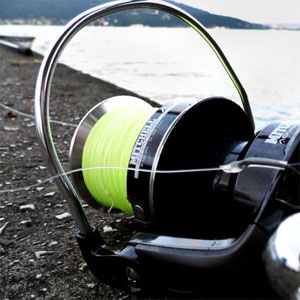
Convert Line Capacitance of a Coil
Every angler wants to get the most out of his or her fishing gear. A balanced combination between the rod and the fishing reel is important for this, but what is sometimes forgotten is the spool. It may be logical that the smoother a line can unwind / roll off a spool, the further you will be able to cast. There are two main factors involved in this.
• The type of coil (deep, big pit)
• How full the bobbin is wound
• Stiffness of the line
• Diameter of the line
The last two are things we can't change much about. If the line used is stiff or has a certain diameter, this will be well thought out. But the first two are impressionable. The type of spool is of course a choice when purchasing the reel. You then have complete control over how full a bobbin is wound up.
Why you should rinse your coil as full as possible
This bobbin is not optimally wound: the edge of the bobbin is still very high
The ease with which a line unwinds from a spool depends on two points. The first is the diameter of the coil itself. The smaller the spool (diameter) is, the more turns the spool has to make for one meter of line. Every revolution costs resistance, so you want to minimize this. When a spool is only half spooled, the actual diameter of the spool+line is smaller than when the spool is completely spooled.
In addition to the diameter, there is another reason why you want to rinse the coil as full as possible. When the spool is only spooled half full, the raised edge of the spool over which the line has to be placed will be larger. With a fully wound spool this is only 1 or 2 mm, while with an empty spool it can be as much as a centimeter. The higher the edge is, the more resistance the line will encounter to get over it. So you want to keep this as low as possible. You don't have this edge with a reel, but you still want to reel a reel as full as possible to keep the diameter of the reel as high as possible.
The line capacity is stated with each mill in the factory data. Suppose it says 0.25mm 180m, but you would like to fish with a line of 0.20mm. How many meters do you need to fill the coil nicely? Fortunately, you can calculate this yourself!
This spool is better spooled: the edge of the spool is only
minimal while the line is already out
Convert the line capacity
Actually it is very simple. Let's take the example of 0.25mm 180 meters of line capacity and you want 0.20mm on it. For the conversion, we first calculate the capacity back to full millimetres. You do this by multiplying the number of meters by the diameter. So in this example it is:
0.25 x 180 = 45 metres
So with a line of 1.00 mm, 45 mm will fit. Now we are going to convert this to 0.20mm. You do this by dividing the result by 0.20, in this case:
45 / 0.20 = 225 meters
And there you have your answer. To completely fill this spool with 0.20 millimeter line you need 225 meters. In most cases you will not use the whole line. When you have an expensive line such as a braided line, it is actually a shame to spool so many meters of it. What you can do is first spool the line with a cheaper nylon line to say 50%, and then spool the next 50% full with the actual line. You can also calculate this theoretically, but it is difficult to keep track of how many meters you have actually spooled up, so it becomes a bit more guesswork. It is also good to know that the line capacity specified by the manufacturers is not always correct. Often the lines are spooled up very tightly and then of course more fits. Therefore, take into account a 10% margin; it is better to have some line left than to be 10% short and your spool is not nicely full!